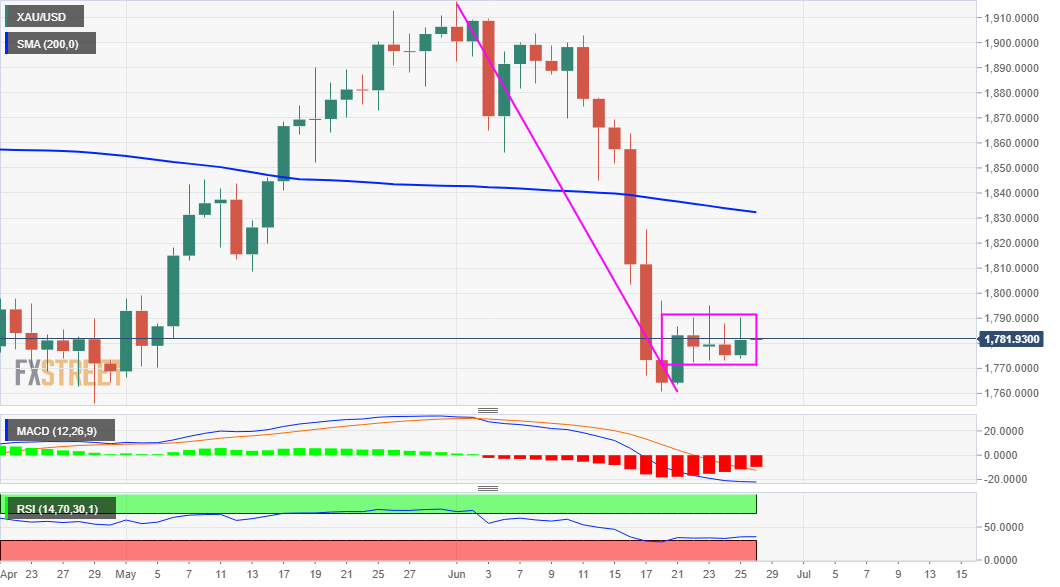- Gold remained confined in a narrow trading band held over the past one week or so.
- The Fed’s sudden hawkish turn, a modest USD strength capped gains for the metal.
- The technical set-up favours bearish traders and supports prospects for further losses.
Gold continued with its struggle to register any meaningful recovery from near two-month lows and has been oscillating in a narrow trading band over the past one week or so. The precious metal took a hit earlier this month after the Fed brought forward its timetable for the first post-pandemic interest rate hike. However, subsequent comments from Fed Chair Jerome Powell soothed market nerves over the potential for early moves by the central bank to rein in its very accommodative monetary policies. During his testimony before the House Select Subcommittee on the Coronavirus Crisis, Powell said that inflation is rising due to pent-up demand and supply bottlenecks and that the price pressures should ease on their own.
The transitory inflation narrative was reaffirmed by Friday's softer core PCE Price Index data, which showed a notable acceleration in May but fell short of market expectations. The Fed’s preferred gauge of inflation shot up to 3.4% in May, marking the largest gain since April 1992. Additional details revealed that consumer spending, which accounts for more than two-thirds of the US economic activity, remained flat following an upwardly revised 0.9% rise in April. This, in turn, extended some support to the non-yielding yellow metal and helped limit the downside, though a combination of factors held bullish traders from placing aggressive bets.
As investors continue to evaluate the Fed's next policy move, the underlying bullish sentiment in the financial markets kept a lid on any meaningful gains for the safe-haven XAU/USD. This, along with a modest US dollar strength acted as a headwind for dollar-denominated commodities, including gold. There isn't any major market-moving economic data due for release from the US, suggesting that the commodity is more likely to extend its subdued range-bound price action on the first day of a new trading week.
Short-term technical outlook
From a technical perspective, the range-bound price action constitutes the formation of a rectangle on short-term charts. Given the recent slump, the rectangle might still be categorized as a bearish consolidation phase and supports prospects for further weakness. The negative bias is reinforced by the lack of any buying interest around the commodity. Hence, a slide back towards retesting monthly swing lows, around the $1,761-60 region, en-route the next major support near the $1,748-47 region, remains a distinct possibility.
On the flip side, the $1,795-$1,800 area now seems to have emerged as immediate strong resistance. A sustained move beyond might trigger a short-covering move towards the $1,815 region. Any further move up might still be seen as a selling opportunity and runs the risk of fizzling out rather quickly near the very important 200-day SMA, currently around the $1,833 region.
Information on these pages contains forward-looking statements that involve risks and uncertainties. Markets and instruments profiled on this page are for informational purposes only and should not in any way come across as a recommendation to buy or sell in these assets. You should do your own thorough research before making any investment decisions. FXStreet does not in any way guarantee that this information is free from mistakes, errors, or material misstatements. It also does not guarantee that this information is of a timely nature. Investing in Open Markets involves a great deal of risk, including the loss of all or a portion of your investment, as well as emotional distress. All risks, losses and costs associated with investing, including total loss of principal, are your responsibility. The views and opinions expressed in this article are those of the authors and do not necessarily reflect the official policy or position of FXStreet nor its advertisers. The author will not be held responsible for information that is found at the end of links posted on this page.
If not otherwise explicitly mentioned in the body of the article, at the time of writing, the author has no position in any stock mentioned in this article and no business relationship with any company mentioned. The author has not received compensation for writing this article, other than from FXStreet.
FXStreet and the author do not provide personalized recommendations. The author makes no representations as to the accuracy, completeness, or suitability of this information. FXStreet and the author will not be liable for any errors, omissions or any losses, injuries or damages arising from this information and its display or use. Errors and omissions excepted.
The author and FXStreet are not registered investment advisors and nothing in this article is intended to be investment advice.
Recommended Content
Editors’ Picks

EUR/USD drops to two-year lows below 1.0400 after weak PMI data
EUR/USD stays under bearish pressure and trades at its weakest level in nearly two years below 1.0400. The data from Germany and the Eurozone showed that the business activity in the private sector contracted in early November, weighing on the Euro.

GBP/USD falls to six-month lows below 1.2550, eyes on US PMI
GBP/USD extends its losses for the third successive session and trades at a fresh fix-month low below 1.2550 on Friday. Disappointing PMI data from the UK weigh on Pound Sterling as market focus shift to US PMI data releases.

Gold price refreshes two-week high, looks to build on momentum beyond $2,700 mark
Gold price hits a fresh two-week top during the first half of the European session on Friday, with bulls now looking to build on the momentum further beyond the $2,700 mark. This marks the fifth successive day of a positive move and is fueled by the global flight to safety amid persistent geopolitical tensions stemming from the intensifying Russia-Ukraine war.

S&P Global PMIs set to signal US economy continued to expand in November
The S&P Global preliminary PMIs for November are likely to show little variation from the October final readings. Markets are undecided on whether the Federal Reserve will lower the policy rate again in December.

A new horizon: The economic outlook in a new leadership and policy era
The economic aftershocks of the COVID pandemic, which have dominated the economic landscape over the past few years, are steadily dissipating. These pandemic-induced economic effects are set to be largely supplanted by economic policy changes that are on the horizon in the United States.

Best Forex Brokers with Low Spreads
VERIFIED Low spreads are crucial for reducing trading costs. Explore top Forex brokers offering competitive spreads and high leverage. Compare options for EUR/USD, GBP/USD, USD/JPY, and Gold.
